The Film that Changed Miami
From the 1980s to 2000s, dozens of film productions used Jimbo's on Miami's Virginia Key as their tropical backwoods set. None of them would have happened without Island Claws (1981) and its narco $$$
The World Famous Jimbo’s
If you ever had the chance to visit Jimbo’s, you know what the final frontier of old Miami looked like — a collection of shacks, shanties, and trailers and one neat rectangle of sand for bocce which at other times housed land crabs and the tabs of decades-old Bud heavies. None of this would have ever existed if not for the 1981 film, Island Claws.
Some folks might hop on here and correct the record. Shows and films used Jimbo’s and the greater Virginia Key as set long before the 1980s. Indeed, classics like Flipper and Gentle Ben used the lagoon on which Jimbo’s sat—known as Lamar Lake—as their crystalline water location; but none of these early productions would include the signature ramshackle set which came to be the Jimbo’s calling card.
In its heyday, Jimbo’s hosted the productions of episodes of Dexter, Burn Notice, Miami Vice, and the very famous boat-jump-onto-yacht scene from 2 Fast 2 Furious. How did this set come to exist?
Jimbo Luznar, a shrimper, squatted on the land where his eponymous watering hole stood. He earned his rights and was allowed to stay until his death. After he passed, his heirs got into an ugly battle over the future of the site and eventually it passed back to the County. It’s gone now.
At first, the property only had a small boat house. The structures which became the Jimbo’s calling cards only arrived with an infusion of good old fashioned 1980s Miami capital.
Enter: Island Claws
It turns out, Miami has its very own Godzilla picture. This should come as no surprise if you’re familiar with Bill Grefe’s B-movie creature features—Sting of Death was filmed in the Everglades, Mako: The Jaws of Death was filmed in Key West, and I Eat Your Skin was filmed in Miami Beach—or that scenes from the Creature from the Black Lagoon were filmed just upstate from us.
Island Claws was co-written by Ricou Browning, the Creature himself. It’s the story of an 18-foot tall land crab which terrorizes the denizens of a small lagoon community on Virginia Key. Land crab researchers from the local oceanic laboratory are carrying out experiments on crabs and noticing spikes in the local population which concur with a leak from the nearby nuclear power plant. Helicopter shots from a live news broadcast in the film feature the actual Turkey Point, an unfathomable visual today thanks to the FPL’s cloistered nature.
Of the film’s $4M budget, nearly one-third was used to bring the giant animatronic crab to life. They called it “Mandy”, short for mandible. How could a film which was never released theatrically and only eventually premiered on television under the name Night of the Claw have had such a beefy budget, you ask? The answer is simple: cocaine.

Island Claws was funded by Dario and Hernan Cardenas. The latter, aged 30 at the time and with no previous film experience, would serve as the film’s director. The former would end up convicted of trafficking 260 pounds of cocaine into New England with their other brother Gabriel and be sentenced to jail in 1985. The Cardenas brothers were not so vocal about their other brother at the time. Their brother-in-law, actually. His name? Jorge Ochoa, a boss of the Medellin cartel.
At one point during filming, producer Ted Swanson said to Hernan point blank, “You guys really are drug dealers.” Cardenas responded, “No, no, no. My family owns a chain of stores in Colombia.” In a 1987 Miami Herald article titled “South Florida Friendly to Cartel Investors”, Yasmin Jean-Baptiste, the County’s assistant film coordinator, was quoted as saying, “The money was there. You don’t usually have that for a first time filmmaker. It was like a toy to them.”
The investors saw a $1 return on their investment when Miami-Dade County purchased the structures to maintain as a film set for the future. “By retaining the fishing village set, there will be provided an incentive for attracting other motion picture and television companies,” city attorney George Knox said in a 1981 Miami Herald article.
More Crabs Please
The NOAA researchers in the film were focused on increasing crab populations as a potential food source. They sped up the phenology of the crustaceans by farming them in hot water tanks — eerily prescient research in the face of rising ocean temperatures and allegorical for our times much? Ironically, they production had difficulty acquiring the number of crabs they needed. Thankfully, they had land crab money.
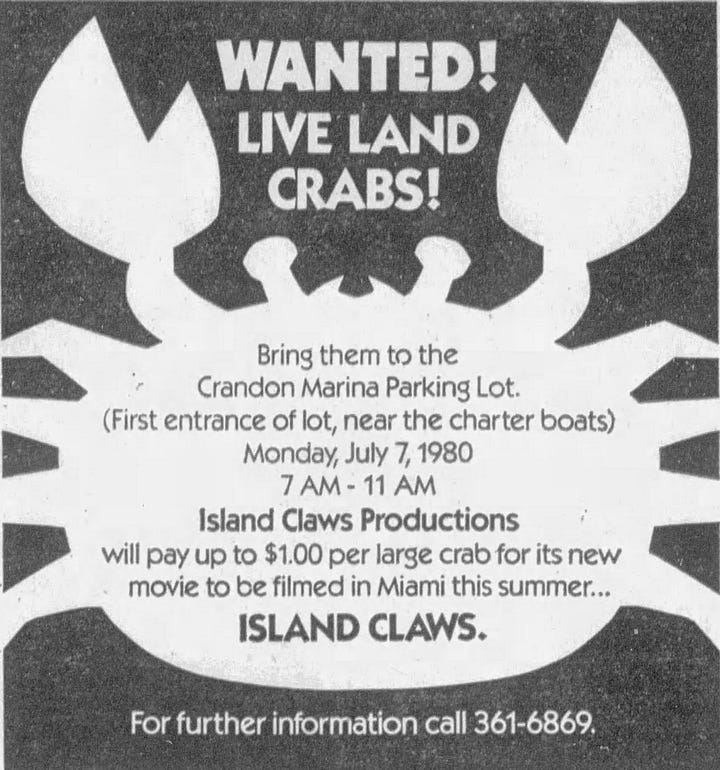
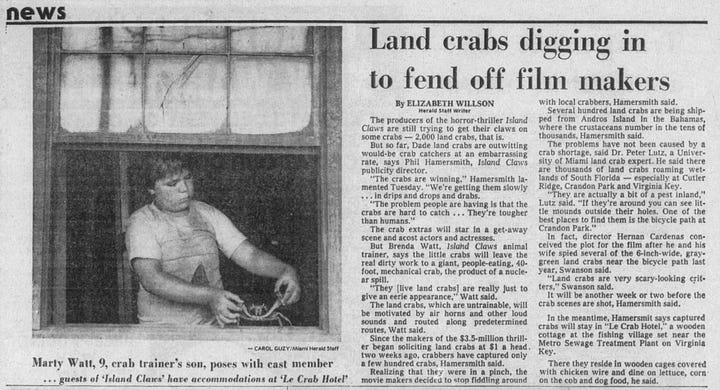
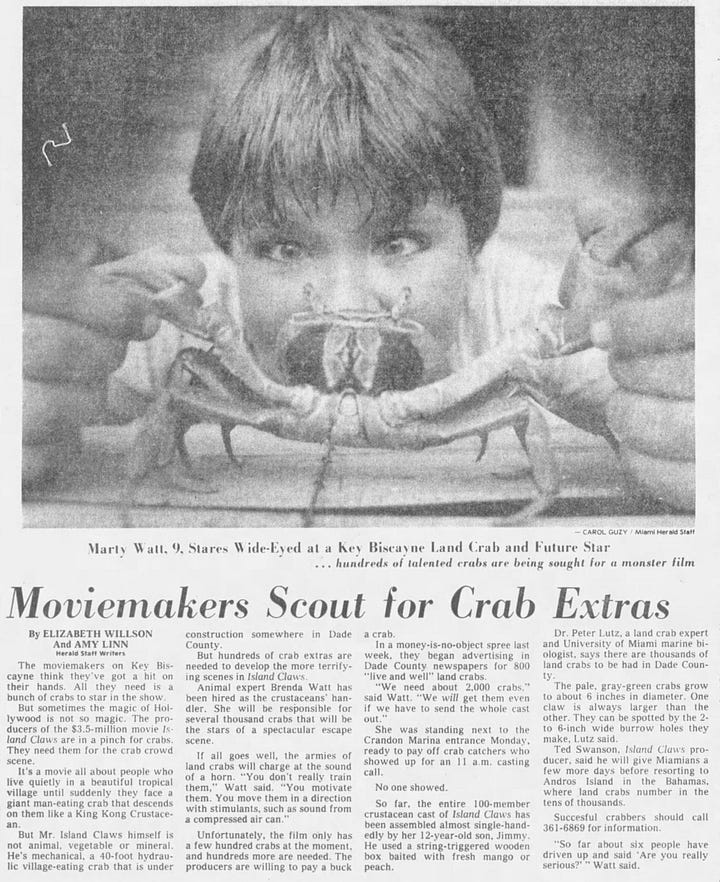
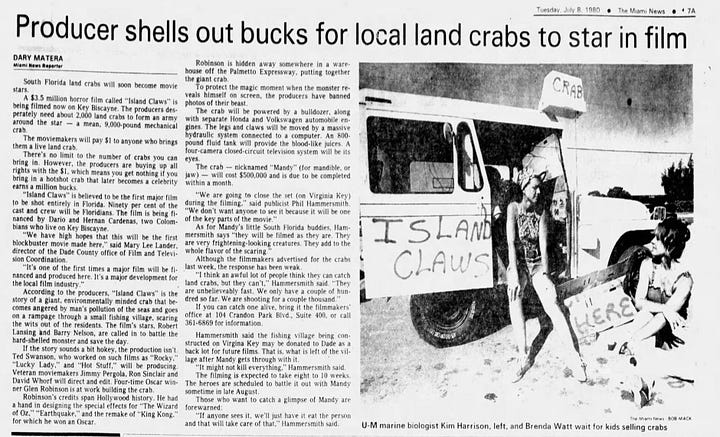
A public call was blasted out in the newspaper. Island Claws was buying crabs at $1/pop. Crabs were shipped in from Andros in the Bahamas. They ended up acquiring 2,000 crabs and housing them in a wooden crate called “Le Crab Hotel”.
What of the Half Shell?
The bar where the terrorized residents of this small fishing village gathered was called the Half Shell. It is a near carbon copy of a bar with the same name which operates in Key West today. When I contacted the owners of the bar in Key West, they had no idea their bar was somehow recreated or had roots in a cocaine-fueled, Miami-set B-movie. How did this come to pass?
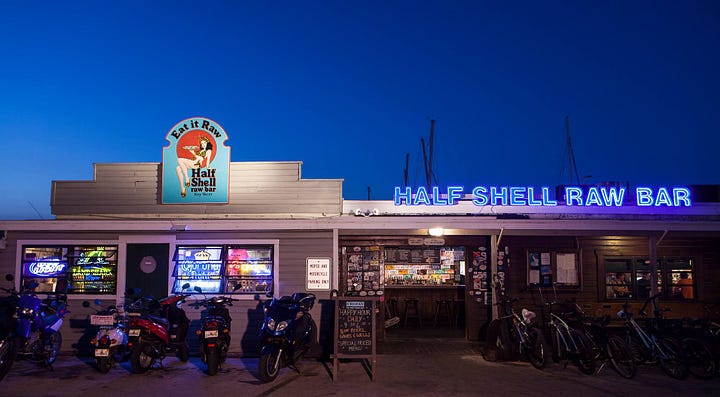

Please comment below or email us at islandiajournal@gmail.com if you have any information about the provenance of the Half Shell. Information was surely lost in the fog of this film…
The spirit of Jimbo’s lives on at Gramps. Just check out this hat designed for the bar by Miami’s Sun & Sons.
Watch Island Claws in is entirety here:




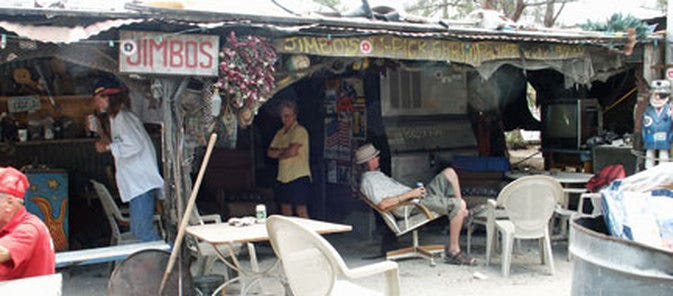



Wonderful memories. Jimbo told a lot of stories of his time there when we were producing the documentary about him and the place. It was wild untamed Miami in its heyday.